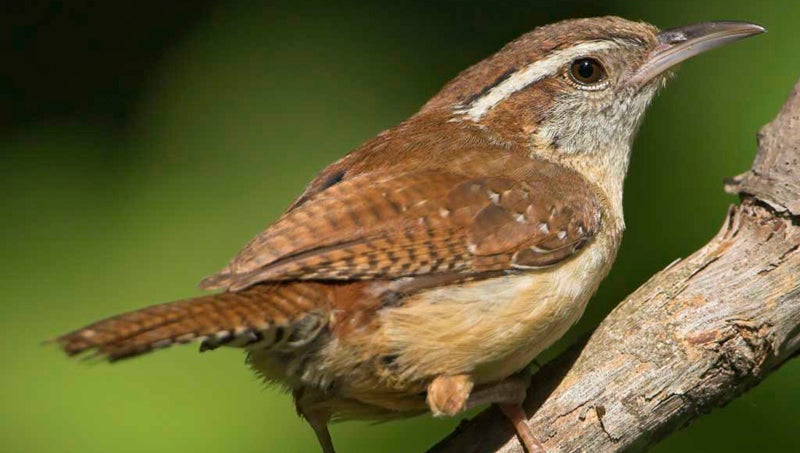‘Wren’ovation
Published 4:33 pm Thursday, July 13, 2017

- (Audubon)
The wren won. For the last two years, we’ve disagreed on appropriate nesting sites. She usually prefers the newly planted spring containers, which when babies arrive, I can no longer water. Like biblical Job, she goes into a pout, because the plants and shade simultaneously wither.
Last year she decided my potting shed was perfect, although the window opening was no larger than the diameter of the electrical cord passing through it. I disagreed. Random pine straw and Carolina wren poop were not acceptable.
This year she thought the screened-in porch was ideal since a squirrel had chewed an entrance in a bottom panel to get to the stored birdseed. (OK, I asked for it.) She selected an abandoned moss-lined container with tossed-in driftwood as a ready-made home. It became a mobile home, as I moved it to the squirrel opening and then to an outside corner.
Five eggs and 13 days of incubation by the female, of course, led to babies two weeks after that. Now everybody’s happy!
To explore more, here are some selected references:
- Cornell Lab of Ornithology — www.audubon.org
- Guide to North American birds — www.audubon.org/birds
This information is given courtesy of the Extension Master Gardeners who are volunteers under the direction of the Beaufort County Cooperative Extension. Volunteers are available through the hotline to answer questions concerning lawns, vegetables, trees, ornamentals, fruits, plant problems and diseases, pests, soil and many other horticulture issues relating to gardening in North Carolina. The hotline number is 252-946-0111, and the hours are Mondays and Wednesdays from 10 a.m. to noon. Leave a voice message at that number, or email the Master Gardeners at beaufortcomg@gmail.com and a volunteer will return the call on the next hotline work day.
Jean Hammond is a certified Master Gardener volunteer.
GARDENING CALENDAR-JULY
Avoid gardening between the hours of 10 a.m. and 4 p.m. to minimize the stress to the plants and to the gardener.
Lawn care
- Fertilize warm-season grasses like bermuda, zoysia and St. Augustine, if you haven’t already done so.
- One-third of the growth should be removed when mowing warm-season grasses.
- Try to change direction when mowing your lawn. This will help strengthen the roots system and expose different sides of the plant to sunlight.
Fertilizing
- Continue side-dressing your garden vegetables.
- July is the last month to fertilize landscape plants.
- Now is a good time to take soil samples from your lawn. Soil boxes can be picked up at the county Extension office.
Planting
- Vegetables to be planted in July: Brussels sprouts, collards, beans, carrots, tomatoes and pumpkins.
- Start broccoli, cabbage and cauliflower plants in peat pots to be transplanted in mid-August.
- Now is a good time to repot overgrown houseplants.
Pruning
- “Bleeder” trees like maple, dogwood, birch and elm can be pruned this month.
- Outgrown hedges can be pruned.
- Pinch off garden mums until mid-July.
- Narrow-leaf evergreens like junipers and arborvitaes can be pruned.
- Fruiting canes of raspberry and blackberry can be cut down to ground level after the harvest.
- Remove faded flowers on flowering perennials to encourage a second flowering.
- Dieback on hybrid rhododendrons, azaleas, and blueberries can be pruned out.
- Lastly, don’t forget to pinch your chrysanthemums to encourage branching.
Spraying
- Watch shrubs for the following insects: bag worms, leaf miners, aphids, spider mites and lace bugs.
- Japanese beetles if needed.
- Use recommended herbicide to control poison ivy and honeysuckle if desired.
- Start fungicide treatment on tomatoes that show signs of blight.
- Continue with rose spraying program.
- Continue fungicide program for fruit trees and bunch grapes.
- Spray the following vegetables if insects are observed: cucumber (cucumber beetle), squash (aphids), tomato and eggplant (flea beetle).
Pesticides should be used sparingly! Use only when needed and always follow the label.
Other activities
- Prune any branches damaged by recent storms.
- Fruit trees that bore no fruit like peach, plum and apple can be pruned as if they were dormant. This will allow more sunlight in and prepare the plant for the next year.
Tips on shopping at farmers markets
- Fresh green beans should “stick” to a T-shirt.
- Stem ends of fresh tomatoes should have a white color.
- Smell may not always be a clue to a cantaloupe’s freshness. Older varieties of cantaloupe have a great smell; however, newer varieties may not have the same smell but taste just as good. No cantaloupe should smell bad. A bad smell is a sign of bacteria and spoilage.





